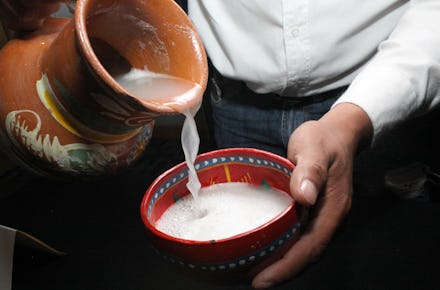What it's like to drink pulque, Mexico's drink of the gods

On a recent visit to Mexico City, I tried pulque at a hispter-ish pulqueria called La Nuclear. The scene at the bar was what I’ve come to think of as “mexcla Mexican teen rebel,” a cross between local culture and American hip hop and punk subcultures. There were stickers covering the bar and cash register and the walls were decorated with chalky murals. The artist Diego Rivera famously commented that pulqueria murals were one of the most important manifestations of Mexican painting. The murals at La Nuclear were traditional in their depictions of inebriation, but they also just kind of looked like really stoned people.
Pulque, for those wondering, is a fermented alcoholic drink made from Agave, the same plant that produces mezcal and tequila. Both mezcal and tequila are made from the cooked heart of certain varieties of agave, while pulque is the fermented sap of the plant. There are a lot of beautiful and lofty legends surrounding pulque, and Aztecs considered it to be the blood of the goddess Mayahuel. Mayhuel is the protector of wombs, and she is often shown as having enough breasts to feed her 400 children, the Centzon Totochtin, or divine rabbits of drunkenness.
I ordered a plain pulque, as my tattoo artist expat friend advised me that the colorful nueva flavored varieties had artificial additives. Pulque curado, another option, is mixed with fresh fruit and is considered best for newbies, but I’m a purist. The unflavored pulque was white and frothy, served in a terracotta mug painted with abstract patterns. Since pulque is considered sacred, I said a little prayer to thank the elements before I tasted it.
The pulque tasted sour — the kind that made me smack my tongue against the roof of my mouth. Other than a vague musty acidity, it had no distinguishable flavor. The texture was a bit slimy, like kombucha, although I heard that fresh, high-quality pulque should not be slimy, so I felt a bit suspicious. It wasn’t really pleasant and I didn’t want to finish it.
I learned from talking to locals in Mexico City that pulque is not actually supposed to be pleasant, like a margarita. Originally, it was for ritual and medicinal use — and still is in many circles. The drink has Mesoamerican origins that date back much further than Spanish colonization. Before the Spanish came, only certain classes of people were allowed to drink pulque. Priests drank it to "gain enthusiasm" and it was even given to victims of sacrifice to ease their passing.
Pulque has an alcohol content of only between 2% and 8%, but it is believed to have other body-calming properties, something like a muscle relaxer. I was coming down with a cold when I tried pulque, so it’s hard to say whether it was the drink or the fever that made me feel bone level tired. Either way, I felt relaxed and slept hard after drinking it.
Pulque doesn’t just get you tipsy, though, it’s also allegedly nutritious. It’s considered an acceptable substitute for blood during atonement ceremonies, and it’s really no wonder. It has many of the same properties as blood, including iron, zinc, and calcium. It also has tons of probiotics and in one glass, there’s usually up to four grams of protein, and it is even considered a food substitute. Between delivering nutrients when I didn’t feel hungry and putting me straight to sleep, pulque might have been exactly what I needed to fend off sickness long enough to enjoy Mexico.
The Spanish made pulque into a recreational cocktail, but it has only become popular in the last century. Neo-pulquerias abound in Mexico City, some of which boast all night dance parties. I can’t really imagine being it a good party drug, unless ritual sacrifice is your kind of party. No judgement here, but I’m skipping pulque until further directed by a shaman.